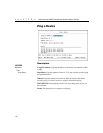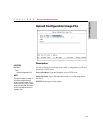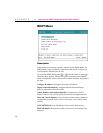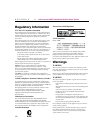
127
Technical Information
APPENDIX A
Appendix A
After I connect to Local Management I see a blank screen.
Why?
• Make sure you are using a null modem cable (included).
• Check the settings in your terminal program. They should be set to
9600 baud, 8 data bits, No parity, 1 stop bit, and No flow control.
• Try pressing c + R to force the screen to refresh.
I keep getting an intermittent loss of link. (or data is not being
transmitted) Why?
• You may be using the wrong grade of cable. The wrong cable can cause
erratic performance and you may eventually lose the connection
between the port and the attached device.
• Check the duplex setting for the device connected to the port. You may
have to use the Local Management or Web Device Manager to force
the port to half or full duplex.
• A cable segment somewhere in your collision domain may be too long.
Make sure none of your UTP cabling is longer than 100 meters.
• Check the Ethernet cable pairs. The TX pairs (pins 1 and 2) and the RX
pairs (pins 3 and 6) should be twisted pairs. See diagram in page 10.
I created a tag-based VLAN, and I have tag-capable LAN
adapters in my PCs, but I can still communicate with devices
outside the VLAN. Why?
Check to make sure that you have assigned a VID to the PC. If you don’t
assign a VID to the NIC in the PC it will behave as an untagged device.
The default VID for untagged devices=1 so all untagged PCs will be a
member of the DEFAULT_VLAN.
Locating MIB files
If you use a MIB browser, you can configure or view statistics for the
switch. You can find these switch MIB files at the Intel Customer Support
Web site at http://support.intel.com/support/express/switches.
• intel.mib • int_pbrd.mib
• int_gen.mib • int_qprd.mib
• int_s460.mib
When compiling the MIBs into an SNMP-compliant management
application, compile the intel.mib first then compile the int_gen.mib,
int_s460.mib, int_pbrd.mib, and int_qprb.mib files.


















